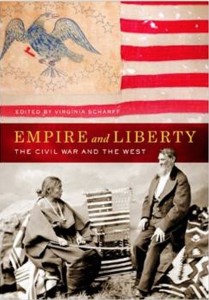Teaching the Civil War and the West
UCLA Graduate Student Works with Teachers to Develop Curriculum connecting the Civil War and the West
By Daniel Lynch, C.Phil. U.S. History
Despite big o verlaps in chronology and content, the Civil War era and the era of U.S. westward expansion have traditionally been researched, taught and understood as if they were mutually exclusive. As we mark the 150th anniversary of the end of the Civil War, we have the opportunity to reassess the important ways in which these eras intertwine. On April 25, the Autry National Center will open an exhibit titled “Empire and Liberty: The Civil War and the West.” The exhibit’s central contention is that you cannot understand the Civil War without addressing the significance of the West, nor the West without considering the causes, contingencies, and consequences of the Civil War.
verlaps in chronology and content, the Civil War era and the era of U.S. westward expansion have traditionally been researched, taught and understood as if they were mutually exclusive. As we mark the 150th anniversary of the end of the Civil War, we have the opportunity to reassess the important ways in which these eras intertwine. On April 25, the Autry National Center will open an exhibit titled “Empire and Liberty: The Civil War and the West.” The exhibit’s central contention is that you cannot understand the Civil War without addressing the significance of the West, nor the West without considering the causes, contingencies, and consequences of the Civil War.
My research focuses on the mid-nineteenth century convergence in greater Los Angeles of Southerners, migrants from the antebellum South, and Californios, the Spanish-surnamed cattle ranchers of Alta California. Southern and California dominance in Southern California between the Mexican American War and the Civil War is revealed in census data, militia records and election returns. Drawing upon these sources as well as personal letters, legislative records, and political propaganda, I concluded that similar seigniorial values regarding masculine honor and the need for rigid social hierarchies stood behind their efforts to control local politics and coordinate vigilante justice. Fittingly known as “the Chivalry,” the political faction supported by Southerners and Californios pushed for state division and the preservation of a local feudal system defined by large rural estates, active mounted militias, and widespread unfree labor.
While working on my dissertation, I have also served as a research assistant to “Empire and Liberty” curator Carolyn Brucken. I have also contributed to the companion volume being published by the University of California Press. My chapter focuses on the saber of a Californio Union veteran and is titled, “On the Edge of Empires, Republics and Identities: De la Guerra’s Sword of the War and the California Native Cavalry.” I will also be co-teaching a curriculum development seminar based on the exhibit with Emma Hipolito, Director of the UCLA HistoryGeography Project. The course, intended for K-12 teachers, is titled “Teaching the Civil War and the American West: A Study in Historical Objects,” and is focused on the saber and several other exhibit objects including a receipt for slaves sold in antebellum Texas; a Bowie knife given to a Cherokee Chief on becoming a Confederate general; and American Progress, an iconic painting of nineteenth-century U.S. development and expansion that, for political reasons, omits the Civil War from American history.
The seminar for teachers was made possible with support from the UCLA Public History Initiative as well as the UCLA History-Geography Project and the Huntington-USC Institute for California and the West. Participating teachers will deepen their content knowledge of the Civil War and the West while developing curriculum around the objects. They will tour the exhibit, read chapters from the companion volume, and interact with the authors in a series of seminars and webinars. They will also write standards-based questions related to each of the objects and produce lesson plans that challenge students to think and write analytically about the Civil War and the West. At the conclusion of the seminar, these educational materials will be made available on the NCHS website.
To find out more about the seminar and to sign-up, visit the UCLA History-Geography Project’s website: http://centerx.gseis.ucla.edu/history-geography
 UCLA history Ph.D. candidate Daniel Lynch is writing his dissertation on the Civil War-era convergence of Southerners and Californios in Southern California. Empire and Liberty: The Civil War and the West, edited by Virginia Scharff, is the companion volume to this year’s Autry National Center exhibit of the same name.
UCLA history Ph.D. candidate Daniel Lynch is writing his dissertation on the Civil War-era convergence of Southerners and Californios in Southern California. Empire and Liberty: The Civil War and the West, edited by Virginia Scharff, is the companion volume to this year’s Autry National Center exhibit of the same name.

